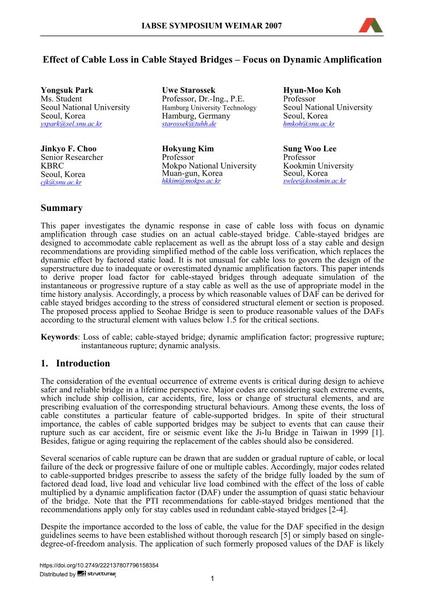Effect of Cable Loss in Cable Stayed Bridges – Focus on Dynamic Amplification

|
|
|||||||||||
Détails bibliographiques
| Auteur(s): |
Yongsuk Park
Uwe Starossek Hyun-Moo Koh Jinkyo Choo Hokyung Kim Sung Woo Lee |
||||
|---|---|---|---|---|---|
| Médium: | papier de conférence | ||||
| Langue(s): | anglais | ||||
| Conférence: | IABSE Symposium: Improving Infrastructure Worldwide, Weimar, Germany, 19-21 September 2007 | ||||
| Publié dans: | IABSE Symposium Weimar 2007 | ||||
|
|||||
| Page(s): | 380-381 | ||||
| Nombre total de pages (du PDF): | 8 | ||||
| Année: | 2007 | ||||
| DOI: | 10.2749/222137807796158354 | ||||
| Abstrait: |
This paper investigates the dynamic response in case of cable loss with focus on dynamic amplification through case studies on an actual cable-stayed bridge. Cable-stayed bridges are designed to accommodate cable replacement as well as the abrupt loss of a stay cable and design recommendations are providing simplified method of the cable loss verification, which replaces the dynamic effect by factored static load. It is not unusual for cable loss to govern the design of the superstructure due to inadequate or overestimated dynamic amplification factors. This paper intends to derive proper load factor for cable-stayed bridges through adequate simulation of the instantaneous or progressive rupture of a stay cable as well as the use of appropriate model in the time history analysis. Accordingly, a process by which reasonable values of DAF can be derived for cable stayed bridges according to the stress of considered structural element or section is proposed. The proposed process applied to Seohae Bridge is seen to produce reasonable values of the DAFs according to the structural element with values below 1.5 for the critical sections. |
||||
| Mots-clé: |
Pont à haubans
|
||||
